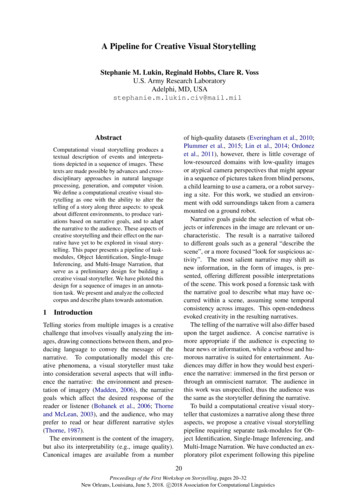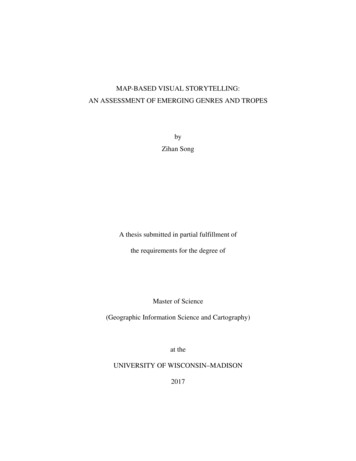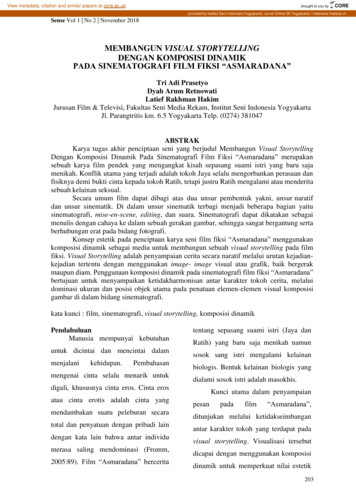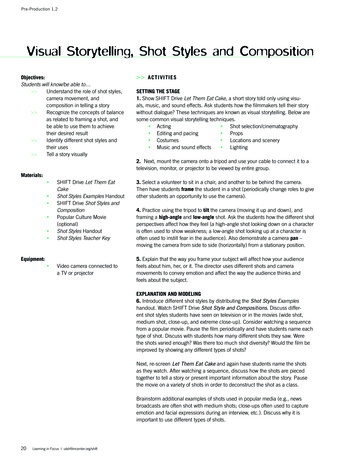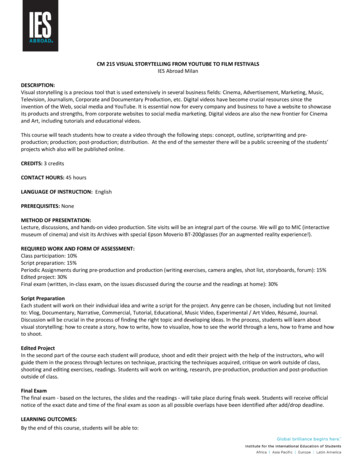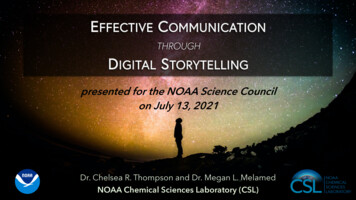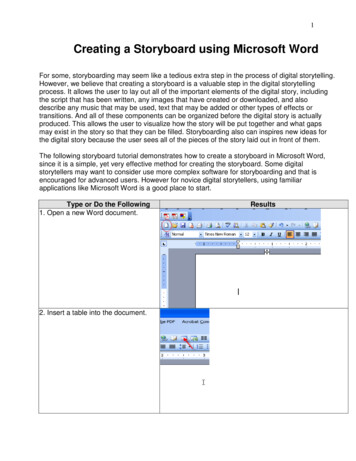
Transcription
DIGITAL STORYTELLINGCOOKBOOKJanuary 2010Joe LambertContributions byAmy HillNina MullenCaleb PaullEmily PaulosThenmozhi SoundararajanDaniel WeinshenkerDigital Diner Press
2010 Joe Lambert, Digital Diner PressISBN: 978-0-9726440-1-3This work is licensed under the Creative Commons Attribution–NonCommercial–ShareAlike 2.5 License. To view a copy of this license, 2.5/or send a letter to Creative Commons, 543 Howard Street, 5th Floor, San Francisco,California,94105, USA.Produced by the Center for Digital Storytelling, a non-profit artsand education organization.Center for Digital Storytelling1803 Martin Luther King Jr. WayBerkeley, CA 94709 2065 tel510-548-1345 faxAlso Available:Digital Storytelling, Capturing Lives, Creating Community, by JoeLambert. Digital Diner Press, 2002; Second Edition 2006, Third Edition, 2009.ii
ContentsPreface.v1 Stories in Our Lives.12 Seven Steps of Digital Storytelling.93 Approaches to Scripting.254 Storyboarding.315 Digitizing Story Elements . .366 Introduction to Photoshop Elements .447 Introduction to Final Cut Express .60
Digital Storytelling CookbookOur work in Digital Storytelling was inspired by the efforts of the late Dana W. Atchley.His performance Next Exit, and the stories he shared, continueto inspire others to honor their lives.Find out more about Dana Atchley’s work at nextexit.com.iv
Preface“Stories move in circles. They don’t move in straight lines. So it helps if you listen incircles. There are stories inside stories and stories between stories, and finding yourway through them is as easy and as hard as finding your way home. And part of thefinding is getting lost. And when you’re lost, you start to look around and listen.”—Corey Fischer, Albert Greenberg, and Naomi NewmanA Travelling Jewish Theatre from Coming from a Great DistanceExcerpted from Writing for Your Life by Deena MetzgerWhen I worked in theater, the first show at my venue was a show by John O’Neal, thelegendary founder of the Free Southern Theater.He was doing one of his Junebug Jabbo Jones stories, recounting the events of the rural south and the civil rights movement. Ten years later to the week, John O’Neal wasthe last performer before I turned my theater over to new managers, performing withNaomi Newman in Crossing the Broken Bridge, a story about African-American andJewish American relations.These bookends of my professional theater experience say a great deal about the rolestory and ancient root cultures played in forming my attitude about the storytellingarts in our civic life. In the tremendous oral traditions of African and Jewish cultures,there is an assessment of storymaking and telling that is synonymous with the valueof life itself. Story is learning, celebrating, healing, and remembering. Each part ofthe life process necessitates it. Failure to make story honor these passages threatensthe consciousness of communal identity. Honoring a life event with the sacrament ofstory is a profound spiritual value for these cultures. It enriches the individual, emotional and cultural development, and perhaps ultimately, the more mysterious development of their soul.The circles of stories passing through the journey of my life as a digital storytellingfacilitator have brought me back to this. As we are made of water, bone, and biochemistry, we are made of stories. The students that share their stories in our circlesrecognize a metamorphosis of sorts, a changing, that makes them feel different abouttheir lives, their identities.In this cookbook, we share with you our storytelling approach. We hope you will findit inspiring as well as useful.Our cookbook has just one recipe, Momnotmom by Thenmozhi Soundararajan. Toview the completed piece, visit us on-line at www.storycenter.org.The rest of this cookbook will break this digital story down into a recipe with ingredients, that will help you to prepare it all again. We’ll talk more about stories in gener-altoo, so you can take this recipe and adapt it to your own tastes. We encourage you tomake the digital story you’re hungry for.— Joe Lambert, DirectorCenter for Digital Storytellingv
Digital Storytelling Cookbook1 Stories in Our LivesA story can be as short as explaining why you bought your first car or house, or aslong as War and Peace. Your own desires in life, the kinds of struggles you have faced,and most importantly, the number and depth of realizations you have taken from yourexperience all shape your natural abilities as an effective storyteller. Translating thoserealizations into stories in the form of essays, memoirs, autobiographies, short stories, novels, plays, screenplays, or multimedia scripts, is mainly about time. You needtime to put the raw material before you, time to learn procedures and approaches forcrafting the story, and time to listen to the feedback and improve upon your efforts.For some, conceiving an idea for a story is an easy process, while for others it is thebeginning of a crisis. The issue of how we get from our conversational use of story tocrafting a work that stands on its own falls more into the category of a general creativeprocess. Why and how do we remember stories? What affects our ability to retain stories? How do we develop our own sense of voice and story? And what kinds of storiesfrom our lives are likely to work as multimedia stories?That Reminds Me of a StoryCultural anthropologist Gregory Bateson was asked in the 1950s if he believed thatcomputer-based artificial intelligence was possible. He responded that he did notknow, but that he believed when you would ask a computer a yes-or-no question andit responded with “that reminds me of a story,” you would be close.Our understanding of how story is at the core of human activity has been a subjectof fascination for academics and experts in the computer age. Educational and artificial intelligence theorist Roger Schank has argued in the last decade that the road tounderstanding human intelligence, and thus the road to artificial intelligence construction, is built on story. In Schank’s 1992 book, Tell Me a Story, he suggests that thecyclical process of developing increasingly complex levels of stories that we apply inincreasingly sophisticated ways to specific situations is one way to map the humancognitive development process. Stories are the large and small instruments of meaning and explanation that we store in our memories.So why is it that when many of us are asked to construct a story as a formal presentation to illustrate an idea, we go blank? We informally tell stories all the time, but theconscious construction of story calls up mental blocks. Here are three possible reasons:Overloaded Memory BankFrom the standpoint of cognitive theory, the problem is about being overwhelmed bystories that we can’t process. Our minds construct a sense of memory immediately after being part of an experience or hearing a story, and unless we have a dramatic experience, or have a particular reason to constantly recite the story of the experience,it slowly diminishes in our memory. Retrieval of a given story or experience becomesmore difficult the farther away we are in time from the original story or event.1
Chapter 1: Stories in Our LivesIn oral culture, we humans learned to retain stories as epigrams, or little tales thathad a meaningful proverb at the end. The constant repetition of epigrammatic talesgave us a stock supply of references to put to appropriate use, like the hundreds ofcowboy sayings I grew up with in Texas, to apply to a wide range of situations. In ourcurrent culture, many of us have not developed an epigrammatic learning equivalentto these processes.At the same time, we are bombarded with millions of non-digestible and non-memorable story fragments every time we pick up a phone, bump into a friend, watch TV,listen to the radio, read a book or a newspaper, or browse the Web. We simply cannotprocess every one of these encounters and turn them into epigrams, let alone reciteand retain them, and so they become a jumble of fragments that actually inhibit ourability to construct a coherent story.Only people who develop effective filtering, indexing, and repackaging tools in theirminds can manage to successfully and consistently articulate meaning that reconstructs a coherent story. We think of the skilled professionals in any given field ashaving developed this process for their specialty. They can tell appropriate stories—the memory of cases for a trial lawyer, for example-based on having systematized aportion of their memories. But most skilled professionals have difficulty using examples outside of their respective fields, from their personal life or non-professionalexperience, but those who do are often described as storytellers.This is one of the arguments for the lifelong Memory Box as a retrieval/filtering/construction system to assist us in this process. Images, videos, sounds, and otherrepresentations of events from our life can help us to reconstruct more completememories and therefore expand the repertoire of story that we can put to use.The EditorHaving worked in arts education settings, we are experienced with people tellingus that they have no story to tell. Along with language arts educators and psychologists, we are aware that most of us carry around a little voice, an editor, that tells usthat what we have to say is not entertaining or substantial enough to be heard. Thateditor is a composite figure of everyone in our lives who has diminished our sense ofcreative ability, from family members, to teachers, to employers, to society as a whole.We live in a culture where expert story-making is a highly valued and rewarded craft.Once we fall behind in developing our natural storytelling abilities to their fullestextent, it takes a much longer commitment and concentration to reclaim those abilities. As adults, time spent in these creative endeavors is generally considered frivolous and marginal by our society, and so few pursue it. Those of us who have assistedpeople in trying to reclaim their voice know that it requires a tremendous sensitivityto successfully bring people to a point where they trust that the stories they do tellare vital, emotionally powerful, and unique. Were it not that we as human beingshave a deep intuitive sense of the power of story, it’s a wonder that we have a popularstorytelling tradition at all.2
Digital Storytelling CookbookThe Good Consumer HabitOur awareness of the residual impact of mass media has grown tremendously overthe past thirty years. Media literacy experts have thoroughly documented that a prolonged exposure to mass media messages over time disintegrates our critical intelligence. The process is, in part, the effect of the over-stimulation we already mentioned.Yet, beyond the fact that we are immersed in too much TV and other media forms, itis the style in which these media, particularly advertising, present themselves thatactually affects our sense of ourselves as storytellers. If I can get more attention forthe kind of shoes I wear or the style of my hair at one-tenth the conscious effort ofexplaining what the heck is wrong or right about my life in a way that moves you, whynot take the simpler route instead? Status and recognition, in our consumer culture, isan off-the-rack item.Finding Your StoryFor all of these reasons and quite a few others, a person’s initial efforts at story-making can be frustrating. We have worked with several high-powered communicatorswho froze up like a deer in the headlights when it came time for them to construct anemotionally-compelling personal tale.The starting point for overcoming a creative block is to start with a small idea. It is anatural tendency to want to make a novel or screenplay out of a portion of our life experiences, and to think in terms of getting all the details. But it is exactly that kind ofscale that disables our memory. Our emphasis on using photographic imagery in ourdigital storytelling workshops facilitates the process of taking a potential story, picture-by-picture. Pedro Meyer, in creating his breathtakingly compelling I Photographto Remember CD-ROM, recorded a narrative by simply setting up a tape recorder inhis living room. He asked his publisher, Bob Stein, to sit beside him as he recorded hisvoice while he described each photograph to Bob. That was it. One take and it becamethe voice-over that was used for the CD-ROM. This process may work for your project.Perhaps your project does not originate with visual material on hand. Take a look atour example interview questions in the next section for various kinds of short personal stories. Have someone interview you, then transcribe the words and see what theytell you about the story you are trying to conceive.As you are putting together your raw material for your story, you are also working tobuild your narrative voice. Everyone has a unique style of expressing him or herselfthat can jump off the page or resonate in a storytelling presentation. Realizing yourvoice, and making it as rich and textured as you are as a person, takes time and practice.The process of moving from a journalistic, technical, or official voice towards a more organic and natural voice is often difficult. It is as if we are trying to merge the two differentparts of our brains: the analytical and the emotive. Most of us can’t switch back and forthwithout getting at least slightly confused. The official voice is the voice of our expositorywriting class, our essays and term papers, or our formal memos and letters to our professional colleagues. We have been taught that this voice carries dispassionate authority,useful perhaps in avoiding misunderstandings, but absolutely deadly as a story.3
Chapter 1: Stories in Our LivesGetting feedback also helps us identify our narrative voice. Reading material aloudto someone who we know well, and asking him or her to identify which part is trueto our voice is a useful practice. Of course, crafting a narrative voice by moving awayfrom clichés and redundancy requires pulling out the thesaurus to substitute common verbs and adjectives. But in the end, take your time and let the ideas and meanings sink in before you edit. If something feels overwhelmingly right, don’t polish ittoo much. We have had lots of scripts that started out fresh and authentic, but by thetime the authors and collaborators got through with it, it was filled with succinct andgorgeous-yet-characterless prose.InterviewingThe following series of question sets for the “Interview” or “Self-Interview” processcan assist in the development of different kinds of stories, but it is not meant to supplant a more direct scripting process if that is how you are accustomed to working.However, almost all of us can gain from having source material that appears from aless self–conscious response to a set of directed questions.In recording your responses, you may find that you have sufficient material to makeyour voice-over. Cutting and rearranging your responses using digital audio editingsoftware may be all that is required. If you take this route, keep in mind that you musttake steps to ensure a good-quality recording.Interviewing TechniquesYou may find it easier to respond to these questions directly into a microphone in theprivacy of your own home or office as opposed to a workshop space. If the prospect oftalking to a recording device is off-putting (and it may be more likely to increase yourself-consciousness than relax you), have someone interview you. This can be a friend, aspouse, relative, or co-worker. This process can be both fun and revealing, but requiresthat the interviewer commit to a few common-sense ideas.Guidelines for the Interviewer1) Study the questions so that you are not reading from the page, and feel free toad lib. Being able to sustain eye contact assists the interviewee in relaxing andresponding in a natural way.2) Allow the interviewee to complete his or her thoughts. Unlike a radio or TVinterviewer that is concerned with “dead air” in the conversation, give the interviewee all the time desired to think through and restate something that is a bitdifficult to articulate. Interruptions can cause people to lose their train of thoughtor become self-aware and steer away from important, but perhaps emotionallydifficult information. Let the interviewee tell you when he or she has finished aquestion before moving on to the next.3) When appropriate, use your own intuition when asking questions to get moredetailed responses. Often, a person’s initial thoughts about a question only retrieves a broad outline of a memory. Feel free to request specifics or details thatwould clarify or expand upon a general response.4
Digital Storytelling Cookbook4) If the story is about information that is specifically painful or traumatic in theperson’s life, carefully assess how far you will allow the respondent to delve intothese memories. In many situations where the interviewer is not a spouse or aloved one, you may cross into territory that is much better approached in a therapeutic environment with experienced guides or professionally trained advisors.We have come perilously close in interviews to taking people into an emotionalstate from which they cannot return at the session. This is embarrassing for therespondent, and an emotionally inconsiderate act on the part of the interviewer, asthe interviewee may not have the therapeutic support to cope with these issues inthe hours and days after the interview. Don’t feel you need to hunt for emotionallycharged material to make the interview effective. If it comes naturally and comfortably, so be it.Finally, along with ensuring privacy in the interview, make sure everyone is comfortable: comfortable chairs, water at hand, and the microphone positioned so as not todisrupt ease of movement. (A lavaliere, or pin-on microphone, is the best).Kinds of Personal StoriesThere are all kinds of stories in our lives that we can develop into multimedia pieces.Here are a few sets of example questions for some of these stories. Adapting anyof the question sets by integrating the existing sets, or developing a separate set, isencouraged.The Story About Someone ImportantCharacter StoriesHow we love, are inspired by, want to recognize, and find meaning in our relationshipsare all aspects of our lives that are deeply important to us. Perhaps the majority of thestories created in our workshops are about a relationship, and in the best stories theytell us more about ourselves than the details of our own life story.Memorial StoriesHonoring and remembering people who have passed is an essential part of the grieving process. These stories are often the most difficult and painful to produce, but theresults can be the most powerful.– What is, or had been, your relationship to this person?– How would you describe this person (physical appearance, character, etc.)?– Is there an event/incident that best captures their character?– What about the person do/did you most enjoy?– What about the person drives you crazy?– What lesson did the person give to you that you feel is most important?– If you had something to say to the person but they never had a chance to hear yousay it, what would it be?5
Chapter 1: Stories in Our LivesThe Story About an Event in My LifeAdventure StoriesOne of the reasons we travel is to break away from the normalcy of our lives andcreate new vivid memories. All of us who travel know that the experience is usuallyan invitation to challenge ourselves, to change our perspective about our lives, andto reassess meaning. We often return from these experiences with personal realizations, and the process of recounting our travel stories is as much about sharing thoserealizations as sharing the sense of beauty or interest in the place visited.Strangely enough, while almost everyone tells good travel stories, it is often difficultto make an effective multimedia piece from these stories. We rarely think about constructing a story with our photographs or videos in advance of a trip. And we do notwant to take ourselves out of the most exhilarating moments by taking out a cameraand recording. Before your next trip, think about creating a story outline based onan idea prior to your visit, as well as what sorts of images, video, or sounds would beuseful to establish the story.Accomplishment StoriesAccomplishment stories are about achieving a goal, like graduating from school, landinga major contract, or being on the winning team in a sporting event. These stories easilyfit into the desire–struggle–realization structure of a classic story. They also tend to bedocumented, so you might find it easy to construct a multimedia story. Televised sporting events have taken up the accomplishment story as a staple, and it might be helpfulfor you to carefully examine an “Olympic moment” to see how they balance the acts ofestablishing information, interviews, and voice-over.– What was the event (time, place, incident, or series of incidents)?– What was your relationship to the event?– With whom did you experience this event?– Was there a defining moment in the event?– How did you feel during this event (fear, exhilaration, sharpened awareness,joy.)?– What did the event teach you?– How did this event change your life?The Story About a Place in My LifeUp until this century, 90% of the world’s population died within a ten-mile radius ofthe home where they were born and raised. While this now might be difficult for us toimagine, our sense of place is still the basis of many profound stories. One of the earliest interactive storytelling websites, 1,000 Rooms, a German-based project, invitedpeople to submit a single image of a room in their home and tell a story about theirrelationship with it. Hundreds of people responded with their own intimate stories.You may have a story about your current home, an ancestral home, a town, a park, amountain or forest you love, a restaurant, store, or gathering place. Your insights intoplace give us insight about your sense of values and connection to community.6
Digital Storytelling Cookbook– How would you describe the place?– With whom did you share this place?– What general experiences do you relate to this place?– Was there a defining experience at the place?– What lessons about yourself do you draw from your relationship to this place?– If you have returned to this place, how has it changed?The Story About What I DoFor many people with professional careers, a life story is shaped by their job. Authorand oral historian, Studs Terkel, collected a series of interviews in his book, Working,to demonstrate that we all have unique ways of perceiving and valuing what we do.And while jobs help to give some people a sense of identity, people also refer to theirhobbies or social-commitments when thinking about who they are.A good story often comes from looking at the familiar in a new way and with a newmeaning. The details of the tasks, the culture of the characters that inhabit our workplace, or our spiritual or philosophical relationship to our work or avocation can leadus into many stories.– What is your profession or ongoing interest?– What experiences, interests, and/or knowledge in your previous life preparedyou for this activity?– Was there an initial event that most affected your decision to pursue this interest?– Who influenced or assisted you in shaping your career, interest, or skill in this area?– How has your profession or interest affected your life as a whole (family, friends,where you live)?– What has been the highlight of your vocation?Other Personal StoriesRecovery StoriesSharing the experience of overcoming a great challenge in life is a fundamentalarchetype in human story making. If you can transmit the range of experience fromdescent, to crisis, to realization, then you can always move an audience.Love StoriesRomance, partnership, familial or fraternal love all naturally lend themselves to thedesire-struggle-realization formula. We all want to know how someone met theirpartner, what it was like when the baby was born, or what our relationship is withour siblings and parents. We constantly test other people’s experiences in thesefundamental relationships to affirm our own. These are also stories that tend to haveplenty of existing documentation.Discovery StoriesThe process of learning is a rich field to mine for stories. The detective in us gets greatpleasure in illustrating how we uncovered the facts to get at a truth, whether it is infixing a broken bicycle or developing a new product.7
Chapter 1: Stories in Our LivesAs you decide what story would best serve your needs, keep in mind that thesecategories are in no way sacrosanct, and they intersect in a number of ways. It is alsoprobable that you will come up with your own additional categories or other ways ofdissecting the stories in your mind.Don’t Just Sit There One of the hardest, but most important thing to do is get started. Because many ofthese stories ask us to reveal things about ourselves that make us feel vulnerable,putting together a story can be a procrastinator’s paradise. Just get up, start answering questions on a tape recorder, write things down, gather up the photos, reviewyour videos, and bounce your ideas off of your friends and family.Life is full of stories, but you may not have a lifetime to capture them as movies, so, gofor it!8
Digital Storytelling Cookbook2 Seven Steps of Digital StorytellingDuring the first few years of our workshops, we would discuss with participants whatmade a story a digital story, and what made a digital story a good digital story. Wecame up with seven elements that outlined the fundamentals of digital storytellingand discovered that formally presenting them at the beginning of workshops greatlyimproved the process and the stories told.Our emphasis over the years has been to help storytellers find the story they want orneed to tell, and then help them clearly define that story in the form of solidly writtenscript. For many storytellers, this process of clarification has proven to be a transformative experience, and for us, a truly rewarding journey. We now look forward tofurther refining this process and evolving the genre. And as we hold onto our originalcommitment to help storytellers sculpt a focused piece of personal writing, we willdiscuss what makes a story a digital story, and what makes a digital story a gooddigital story.To that end, this rewrite of the elements reflects where we stand in this journey. Itis not only a renaming and reordering of the elements, but a complete rethinking ofour approach to digital storytelling. And because we view the storytelling process asa journey, we feel that framing our approach around the metaphor of “Steps,” ratherthan “Elements,” will more practically guide storytellers along the path of creating ameaningful digital story.We want stories. We love stories. Stories keep us alive. Stories that come from a placeof deep insight and with a knowing wink to their audience, and stories that tease usinto examining our own feelings and beliefs, and stories that guide us on our ownpath. But most importantly, stories told as stories.What’s new in this rewrite is the idea that we are helping our storytellers fully visualize their story as a finished piece before they begin to write their script. This meansthat during our group process called the Story Circle, which is discussed at lengthlater in the book, we want to help each storyteller not only find and clarify the storybeing told, but also check in with them about how they feel about it, identify themoment of change in their story, then use that to help them think through how theaudience will see and hear their story in the form of a digital story. And finally, afterthe Story Circle is completed, and the storyteller has had some time alone with hisor her thoughts, they can then let all of these considerations inform them as they sitdown to write.Step 1: Owning Your InsightsWe want to help storytellers find and clarify what their stories are about. We oftenstart with the question: “What’s the story you want to tell?” and then as a follow-up,“What do you think your story means?” We want to hear not just what the story isabout in the obvious sense: “It’s about my mom, my vacation, my first real job ” Butwhat it’s really about: the storyteller, as the person who lived through the story. Andwhat it’s about between the lines. “This story is about my toaster but really it’s about9
Chapter 2: Seven Stepslosing my mom to cancer when I was five but it’s really about how that experiencetaught me that I am given chances to learn to trust again, over and over.”Finding and clarifying what a story is really about isn’t easy. It’s a journey in whicha storyteller’s insight or wisdom can evolve, even revealing an unexpected outcome.Helping storytellers find and own their deepest insights is the part of the journey weenjoy the most. This process can take time to unfold through check-ins and downtimeduring the duration of a multi-day workshop. Other questions that we ask to help storytellers are simple to ask, but can be difficult to answer: “Why this story? Why now?What makes it today’s version of the story? What makes it your version of the story?Who’s it for? Who’s it to? How does this story show who you are? How does this storyshow why you are w
In this cookbook, we share with you our storytelling approach. We hope you will find it inspiring as well as useful. Our cookbook has just one recipe, Momnotmom by Thenmozhi Soundararajan. To view the completed piece, visit us on-line at www.storycenter.org. The rest of this cookbook will



